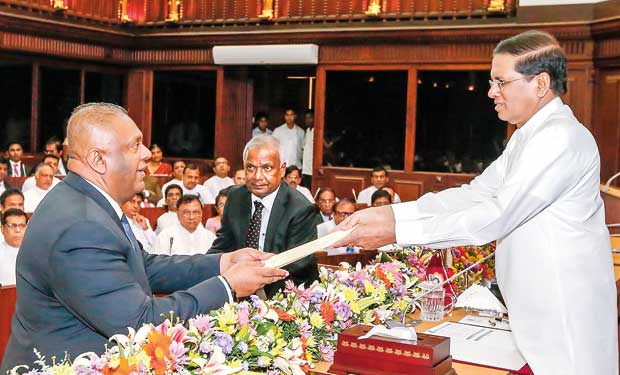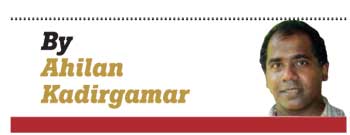Imports and the ailing Economy



 2017-06-05
2017-06-05



 2017-06-05
2017-06-05
The recent cabinet reshuffle and the new composition of the Finance Ministry has evoked much anticipation. Will the new Finance Minister, Mangala Samaraweera, succeed in revitalising Sri Lanka’s ailing economy?
Before getting into what the Ministry, under his leadership, may or may not be able to achieve, let us look at where the economy stands. Exactly a year ago, Sri Lanka signed the IMF Extended Fund Facility agreement in June 2016 with stringent conditions for a US$ 1.5 billion loan. However, over the last year the national economy has continued to deteriorate with a widening trade deficit and falling foreign reserves. As some of us have consistently warned, including at the time of the IMF Agreement, neo-liberal policies characterised by the dominance of finance, the market and urban build-out while undermining the rural economy and social welfare services, only aggravate the crisis prone character of the Sri Lankan economy. However, such policies help tycoons and businesses involved in finance, trade and construction,to make windfall profits.
Agreement, neo-liberal policies characterised by the dominance of finance, the market and urban build-out while undermining the rural economy and social welfare services, only aggravate the crisis prone character of the Sri Lankan economy. However, such policies help tycoons and businesses involved in finance, trade and construction,to make windfall profits.
It is not just the flawed analysis of the policymakers and think tanks in Colombo and the problematic economic vision of the Government that is at fault. Rather, it is also the policy prescriptions of the international institutions such as the IMF and the World Bank, serving the interests of global capital that worsen the situation. When countries like Sri Lanka turn to development aid or relief during times of crisis, the policies advocated by international financial institutions and supported by the national elite, often exacerbate the crisis conditions in the economy by pushing for trade liberalisation, financialisation and privatisation.
Before getting into what the Ministry, under his leadership, may or may not be able to achieve, let us look at where the economy stands. Exactly a year ago, Sri Lanka signed the IMF Extended Fund Facility agreement in June 2016 with stringent conditions for a US$ 1.5 billion loan. However, over the last year the national economy has continued to deteriorate with a widening trade deficit and falling foreign reserves. As some of us have consistently warned, including at the time of the IMF
 Agreement, neo-liberal policies characterised by the dominance of finance, the market and urban build-out while undermining the rural economy and social welfare services, only aggravate the crisis prone character of the Sri Lankan economy. However, such policies help tycoons and businesses involved in finance, trade and construction,to make windfall profits.
Agreement, neo-liberal policies characterised by the dominance of finance, the market and urban build-out while undermining the rural economy and social welfare services, only aggravate the crisis prone character of the Sri Lankan economy. However, such policies help tycoons and businesses involved in finance, trade and construction,to make windfall profits.It is not just the flawed analysis of the policymakers and think tanks in Colombo and the problematic economic vision of the Government that is at fault. Rather, it is also the policy prescriptions of the international institutions such as the IMF and the World Bank, serving the interests of global capital that worsen the situation. When countries like Sri Lanka turn to development aid or relief during times of crisis, the policies advocated by international financial institutions and supported by the national elite, often exacerbate the crisis conditions in the economy by pushing for trade liberalisation, financialisation and privatisation.
"Whether it is the drought or the floods, it is the most marginal sections of our society that are worst hit by such natural disasters. The structure of our state, society and economy, lead to their continuing travails as they live in the most vulnerable locations."
From Budget to Budget, even as funds for state services have been cut, managing external finances of the country has not got any easier. After the war, the Rajapaksa regime bubbled up the economy through growth driven by debt-led construction, when global capital flowed into developing countries after the global economic crisis of 2008. The regime opened the country to speculative external financiers and accumulated unsustainable foreign debt. Furthermore, after regime change in 2015, those policies were further expanded by rolling over previous debt with more international loans, even as it became increasingly difficult to borrow in the global markets.
When analysing any economic crisis, the question that always emerges is - for whom? The crisis facing Sri Lanka is two-fold. The Government is trapped by increasing foreign debt and widening trade deficit. The working people in the towns and the countryside, are struggling with increasing costs of living and very less social welfare. They are having to pay high prices for supposedly free services such as education and healthcare.
When analysing any economic crisis, the question that always emerges is - for whom? The crisis facing Sri Lanka is two-fold. The Government is trapped by increasing foreign debt and widening trade deficit. The working people in the towns and the countryside, are struggling with increasing costs of living and very less social welfare. They are having to pay high prices for supposedly free services such as education and healthcare.
Government troubles
At the heart of the economic troubles facing the Government are the increasing trade deficit and the falling foreign reserves to pay for the imports. The writing was all over the wall, when this Government came to power in 2015, that the trade deficit was widening and that it could not finance the massive import bill with foreign loans. It does not take a rocket scientist to figure out that imports had to be restricted, but the Government and its ideologues refused to consider restricting imports and idiotically sought further trade liberalisation.
There could be no worse time to expand trade as global trade growth has been declining. Brexit and US trade policies under Trump are powerful manifestations of a world turning protectionist. Contrary to some economists’ claims that trade is well and kicking in Asia, even the Asian powers such as China and India with whom Sri Lanka is eagerly negotiating trade pacts, are greatly contracting imports into their economies. According to data released by the World Trade Organization, between 2012 and 2016, imports into China and India, had fallen from US$ 150 billion to US$ 100 billion and US$ 40 billion to US$ 30 billion, respectively. In other words, there is a tremendous decline in the demand for exports from other countries into China and India. This shift in trade flows is also a major cause for falling exports from Sri Lanka, and the obvious and most crucial response ought to be restricting imports, but that is taboo for the neo-liberals, as they believe markets forces, balancing the budget and ending corruption will fix the economy.
The IMF blames the budget deficit for Sri Lanka’s economic woes. Of course, the tremendously low tax revenues amounting to just 12.4% of GDP have to go up, as the wealthier classes get away with paying little in the form of direct taxes and much of the tax burden is on the working people in the form of VAT. But successive Budgets have only sought to decrease government expenditure, which compared to most other countries is already low. Furthermore, no amount of reducing Government expenditure which is 19.7% of the GDP is going to address the foreign exchange problems which is mainly due to foreign imports for private consumption, including luxury items for the rich.
In any event, crises have a way of giving governments a bitter reality check, and taboo or not, the Government has finally accepted that imports have to be restricted. Hopefully, this will also prick the pipe dreams of the neo-liberal ideologues about Sri Lanka fast becoming the next Singapore through an international financial centre. That will only subject Sri Lanka to further risks of speculative financial crises. For the millions of working people even everyday survival has become a serious concern while the rich wax eloquently about Singapore.
There could be no worse time to expand trade as global trade growth has been declining. Brexit and US trade policies under Trump are powerful manifestations of a world turning protectionist. Contrary to some economists’ claims that trade is well and kicking in Asia, even the Asian powers such as China and India with whom Sri Lanka is eagerly negotiating trade pacts, are greatly contracting imports into their economies. According to data released by the World Trade Organization, between 2012 and 2016, imports into China and India, had fallen from US$ 150 billion to US$ 100 billion and US$ 40 billion to US$ 30 billion, respectively. In other words, there is a tremendous decline in the demand for exports from other countries into China and India. This shift in trade flows is also a major cause for falling exports from Sri Lanka, and the obvious and most crucial response ought to be restricting imports, but that is taboo for the neo-liberals, as they believe markets forces, balancing the budget and ending corruption will fix the economy.
The IMF blames the budget deficit for Sri Lanka’s economic woes. Of course, the tremendously low tax revenues amounting to just 12.4% of GDP have to go up, as the wealthier classes get away with paying little in the form of direct taxes and much of the tax burden is on the working people in the form of VAT. But successive Budgets have only sought to decrease government expenditure, which compared to most other countries is already low. Furthermore, no amount of reducing Government expenditure which is 19.7% of the GDP is going to address the foreign exchange problems which is mainly due to foreign imports for private consumption, including luxury items for the rich.
In any event, crises have a way of giving governments a bitter reality check, and taboo or not, the Government has finally accepted that imports have to be restricted. Hopefully, this will also prick the pipe dreams of the neo-liberal ideologues about Sri Lanka fast becoming the next Singapore through an international financial centre. That will only subject Sri Lanka to further risks of speculative financial crises. For the millions of working people even everyday survival has become a serious concern while the rich wax eloquently about Singapore.
Rural vengeance
There is a common refrain by neo-liberal ideologues that dismisses agriculture and fisheries, claiming that 30% of the population produces just 10% of the GDP. They claim there is no future for such an unproductive rural sector. The question, however, is whether that 30% of the population gets even 10% of the share of GDP for their agricultural and fish work? They only get a fraction of the value they have produced, as the traders, the financial institutions and loan sharks siphon off their earnings.
"The Government is trapped by increasing foreign debt and widening trade deficit. The working people in the towns and the countryside, are struggling with increasing costs of living and very less social welfare."
Therefore, a major problem is the lack of redistribution, leading to massive inequalities.
Next, many of these agricultural households are involved in multiple economic activities, including in rural and urban services, migrant urban work and foreign employment. However, their economic life with such diversified income sources depends on them being able to fall back on agricultural production. A woman working in the exploitative garment sector can only do such work for a decade or less before she burns-out, similarly migrant work in the Middle East is also for a limited period. Therefore, even for our export and foreign exchange earning workers, the agricultural sector remains the important economic base.
For the thick headed economists the rural economy remained insignificant until the drought hit the economy head on. It was when agricultural production contracted that they realized it was crippling their economic growth forecasts. According to the Central Bank, agricultural production during the last quarter of 2016 has declined by 8.4%. Moreover, what is not produced by our agricultural sector due to the drought has to be imported expending valuable foreign exchange, which according to the Central Bank is going to amount to an addition US$ 800 million this year.
If we ignore the ideological pronouncements of the economists and look at the import bill, it looks like this. In 2016, Sri Lanka’s exports were US$ 10.3 billion, but imports were US$ 19.4 billion. Furthermore, of this amount as much as US$ 1.6 billion is for food and beverages, excluding the US$ 250 million in wheat and maize imports. Sri Lanka imports US$ 490 million on paper and paper boards. It begs the question, why are there no efforts to substitute such imports with local production?
Next, many of these agricultural households are involved in multiple economic activities, including in rural and urban services, migrant urban work and foreign employment. However, their economic life with such diversified income sources depends on them being able to fall back on agricultural production. A woman working in the exploitative garment sector can only do such work for a decade or less before she burns-out, similarly migrant work in the Middle East is also for a limited period. Therefore, even for our export and foreign exchange earning workers, the agricultural sector remains the important economic base.
For the thick headed economists the rural economy remained insignificant until the drought hit the economy head on. It was when agricultural production contracted that they realized it was crippling their economic growth forecasts. According to the Central Bank, agricultural production during the last quarter of 2016 has declined by 8.4%. Moreover, what is not produced by our agricultural sector due to the drought has to be imported expending valuable foreign exchange, which according to the Central Bank is going to amount to an addition US$ 800 million this year.
If we ignore the ideological pronouncements of the economists and look at the import bill, it looks like this. In 2016, Sri Lanka’s exports were US$ 10.3 billion, but imports were US$ 19.4 billion. Furthermore, of this amount as much as US$ 1.6 billion is for food and beverages, excluding the US$ 250 million in wheat and maize imports. Sri Lanka imports US$ 490 million on paper and paper boards. It begs the question, why are there no efforts to substitute such imports with local production?
Re-thinking policies
Whether it is the drought or the floods, it is the marginal sections of our society that are worst hit by such natural disasters. The structure of our state, society and economy, lead to their continuing travails as they live in the most vulnerable locations. Climate change we know is a reality, and the increasing incidence of droughts and floods are a given, but what investment is the Government making to guard the vulnerable sections of our society and the rural economy, against such repeated disasters?When state policies continue to neglect the rural and urban poor, from their economic activities to their living conditions, they have no choice but to resort to protests.
In this scenario, can we be dewy-eyed about the new leadership in the Finance Ministry? Will Minister Samaraweera be able to bring about any fundamental shift in policy?
While there finally seems to be recognition of the importance of restricting imports and increasing agricultural production, on the larger policies of trade liberalisation, financialisation and privatisation, there is no shift. Continuing with the neo-liberal economic policy trajectory will inevitably result in a deep economic crisis, where state assets accumulated over decades will be sold to pay off foreign loans and the large import bill. But that will only further ruin the economic life of the citizenry as they get ripped off by private services.Will the Government at least now rethink its policies?
In this scenario, can we be dewy-eyed about the new leadership in the Finance Ministry? Will Minister Samaraweera be able to bring about any fundamental shift in policy?
While there finally seems to be recognition of the importance of restricting imports and increasing agricultural production, on the larger policies of trade liberalisation, financialisation and privatisation, there is no shift. Continuing with the neo-liberal economic policy trajectory will inevitably result in a deep economic crisis, where state assets accumulated over decades will be sold to pay off foreign loans and the large import bill. But that will only further ruin the economic life of the citizenry as they get ripped off by private services.Will the Government at least now rethink its policies?
